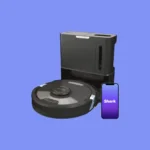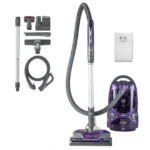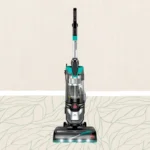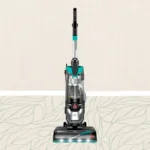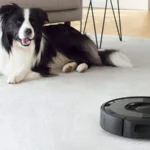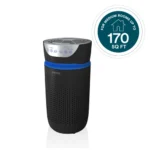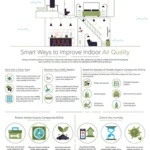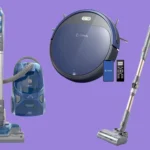Have you ever found yourself constantly sneezing or suffering from allergies whenever you’re indoors? Are you struggling to find a solution to your allergy problems, even though you clean your home on a regular basis? The answer to your problems may lie in a smart vacuum cleaner with anti-allergen technology. By utilizing HEPA filtration, UV-C light technology, and cyclone technology, these innovative cleaners are designed to improve air quality, eliminate dust mites and their allergens, and reduce asthma and allergy symptoms. In this article, we’ll explore the benefits of using smart vacuum cleaners with anti-allergen technology and highlight the key features to look out for when selecting one for your home.
What is Anti-Allergen Technology?
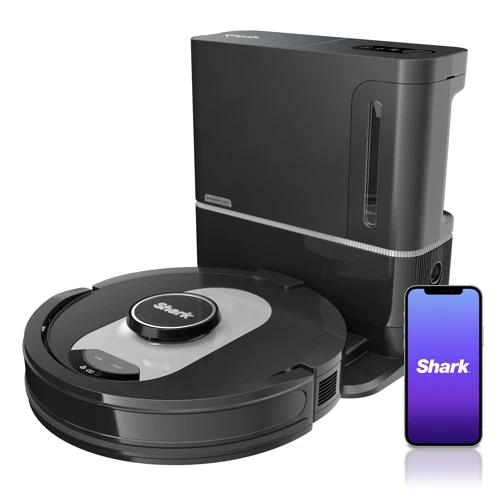
Have you ever wondered what Anti-Allergen Technology in smart vacuum cleaners that everyone is talking about? These vacuums have become extremely important in homes because they can effectively remove allergens and particles in the air, reducing the risk of allergy and asthma attacks. But what exactly is Anti-Allergen Technology and how does it work? In the following sections, we will discuss the different technologies that are used in smart vacuums with Anti-Allergen Technology, and how they can benefit your health. If you want to learn more about the benefits of using Anti-Allergen Technology in smart vacuums, check out our article “Smart Vacuums: A Solution for Allergies and Asthma?”.
HEPA filtration
HEPA filtration is an important feature that should be considered when looking for anti-allergen smart vacuums. HEPA stands for high-efficiency particulate air, and it refers to a type of filter that can capture particles as small as 0.3 microns with an efficiency rate of 99.97%. This means that even the smallest allergens like dust mites, pollen, pet dander, and mold spores can be trapped and prevented from circulating back to the air.
HEPA filters are composed of a dense layer of glass fibers that would trap tiny particles that are otherwise impossible to catch. The filters are usually installed in the exhaust of a vacuum cleaner, ensuring that even the smallest allergens are trapped before the air is released back into the environment. The multi-stage filtration process starts with a pre-filter that traps larger debris, followed by the HEPA filter that can capture even the smallest allergens.
HEPA filtration is an essential feature of an anti-allergen smart vacuum cleaner. It is recommended to maintain the filter regularly, typically after 6 months to ensure its optimum performance. Cleaning or replacing the filter regularly prevents clogging and ensures that the vacuum operates at peak efficiency. Although the cost of replacing HEPA filters can be expensive, most manufacturers offer washable or reusable HEPA filters that can withstand multiple cleanings.
A vacuum cleaner with an efficient HEPA filtration system is especially important for people who suffer from allergies or asthma because it can reduce their exposure to allergens and consequently alleviate some of their symptoms. Household allergens can trigger a variety of health problems, including respiratory difficulties, skin irritation, and allergic reactions. With a trusted smart vacuum cleaner with HEPA filtration, you can rest assured that allergens will not circulate in your home and affect your family’s health.
HEPA filtration is a crucial feature of an anti-allergen smart vacuum cleaner. This type of filter can efficiently capture even the smallest allergens and prevent them from recirculating back into a living environment. To ensure it operates at peak performance, it is important to regularly maintain HEPA filters, whether through cleaning or replacement. Investing in an anti-allergen smart vacuum cleaner can greatly benefit people with allergies or asthma by reducing their exposure to allergens and alleviating their symptoms.
UV-C light technology
One of the key components of anti-allergen technology in vacuums is the use of UV-C light. This technology refers to the use of ultraviolet radiation with a wavelength of 200-280 nm, which is known to neutralize microorganisms, including bacteria, viruses, and even dust mites. UV-C light has been proven to be effective against a variety of pathogens and is commonly used in hospitals and laboratories for disinfection.
In smart vacuums, UV-C light technology is used to kill dust mites and their allergens that may be embedded in carpets, upholstery, or bedding. When the vacuum passes over these surfaces, the UV-C light penetrates the cell membranes of the dust mites and disrupts their DNA, effectively killing them and making them harmless to humans.
Some of the benefits of using a smart vacuum with UV-C light technology include:
- Improved Air Quality: By eliminating dust mites and their allergens, UV-C light technology helps to improve the overall air quality in your home.
- Reduced Risk of Allergic Reactions: With fewer allergens in your home, the risk of experiencing an allergic reaction is significantly reduced.
- Better Sleep: Dust mites can disrupt your sleep and trigger allergic reactions. By eliminating them, you may find that you sleep better and wake up feeling more rested.
To maintain the anti-allergen technology in smart vacuums that use UV-C light, it’s important to regularly clean and replace the filters as recommended by the manufacturer. Doing so will ensure that the vacuum continues to effectively capture and neutralize allergens in your home.
For more information on how to maintain anti-allergen technology in smart vacuums, check out our article on maintaining anti-allergen technology in smart vacuums.
Cyclone Technology
Cyclone Technology is a powerful vacuum technology that utilizes centrifugal force to remove dust and dirt particles from the air. It is an essential feature of modern smart vacuum cleaners designed to combat allergens effectively. This technology is used in modern vacuums to prevent dust particles from escaping back into the air during the vacuuming process.
How Does Cyclone Technology Work?
Cyclone Technology works based on the centrifugal force principle. The air and dirt particles are sucked into the vacuum cleaner and forced through multiple cyclones, which spin the debris around at high speed. The spinning motion of the cyclones creates a force that separates the dirt particles from the air. This separates the dirt and dust particles, causing them to fall into the dustbin or removable compartment, while the filtered air is returned back to the room.
The Advantages of Cyclone Technology in Smart Vacuums
Cyclone Technology is an excellent technology that provides the following benefits:
| Advantages | Description |
|---|---|
| Improved Air Quality | The technology helps in removing dust, dirt, and other impurities from the air, improving air quality. |
| High Efficiency | It is a fast and efficient cleaning method, ensuring that all dirt particles are removed from surfaces. |
| Cleaner Surfaces | Cyclone technology ensures that surfaces are left cleaner because it removes more dirt, dust, and allergens than regular vacuum cleaners. |
| Allergy Relief | Cyclone technology is particularly beneficial to people with allergies, as it can remove house dust mites, pet dander, pollen, and other allergens. |
Conclusion
Cyclone Technology is an essential feature of modern, anti-allergen smart vacuums designed to tackle the problem of allergens in the home. It works by using centrifugal force to remove particles from the air, improving air quality and eliminating allergens. Smart vacuums equipped with Cyclone Technology have proven to be more efficient, faster, and provide unique benefits when it comes to the removal of dirt and allergens from surfaces.
Benefits of Using Smart Vacuum Cleaners with Anti-Allergen Technology
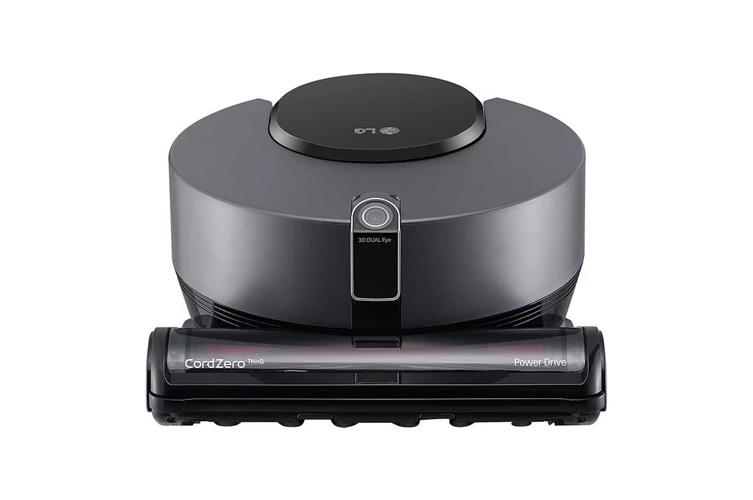
It’s a fact that dust and allergens circulating in the air can exacerbate allergy and asthma symptoms, leading to discomfort and poor health. Thankfully, with the rise of smart vacuum cleaners with anti-allergen technology, you no longer have to suffer in silence. By using the latest advancements in filtration, suction power, and smart sensors, these vacuums boast impressive features that can significantly minimise air pollution, eliminate dust mites, and reduce allergy and asthma symptoms. Here are some of the top benefits of using smart vacuums with anti-allergen technology that you need to know.
Improved Air Quality
One of the primary benefits of using smart vacuum cleaners with anti-allergen technology is improved air quality. Here are a few reasons why:
- HEPA filtration: Smart vacuums equipped with HEPA filters help capture particles and allergens as small as 0.3 microns from the air, making sure that you breathe in cleaner air.
- UV-C light technology: Some smart vacuums come with UV-C light technology that can kill bacteria, viruses, and other germs present on floors, carpets and other surfaces in the home.
- Cyclone Technology: Smart vacuums with cyclonic separation can efficiently separate dust and dirt from the air and trap it in the bin, ensuring that filtered air is released back into the home.
With the combination of HEPA filtration and other anti-allergen technologies, smart vacuums help to eliminate dust, mold spores, pet dander, pollen, and other common allergens that can cause respiratory problems, including asthma and allergies. By properly cleaning the air in your home, you’ll breathe easier and experience fewer allergy symptoms.
Elimination of Dust Mites and Their Allergens
Dust mites and their allergens can be a major problem in households, especially for individuals who are susceptible to allergies or asthma. These tiny creatures thrive in warm, humid environments and can be found in bedding, carpets, and other soft surfaces.
Using a smart vacuum cleaner with anti-allergen technology can help to eliminate dust mites and their allergens from your home. Here are some reasons why:
1. HEPA filtration: Many smart vacuums are equipped with HEPA filters which are designed to trap even the smallest particles, including dust mites and their allergens. These filters are capable of capturing up to 99.97% of particles as small as 0.3 microns, ensuring that your home is free from these allergens.
2. UV-C light technology: Some smart vacuums come with UV-C light technology which is used to kill dust mites and other bacteria. The light emits a wavelength that disrupts the DNA of the dust mites, thus eliminating them and their allergens.
3. Cyclone Technology: Cyclone technology is used in some smart vacuums to create a powerful cyclone that separates dust and debris from the air, preventing it from re-entering the environment. This technology helps to ensure that dust mites and their allergens are effectively removed from your home.
4. Efficient suction power: Smart vacuums with high suction power can effectively suck up dust mites and their allergens from carpets, rugs, and other soft surfaces. This ensures that these allergens are removed from your home and do not trigger any allergic reactions.
Using a smart vacuum cleaner with anti-allergen technology can help to eliminate dust mites and their allergens from your home, creating a safer and healthier environment for you and your family.
Reduction in Asthma and Allergy Symptoms
When it comes to asthma and allergies, many of us are aware of the triggers that can make symptoms worse. Dust mites and other allergens can cause breathing difficulties, coughing, and other unpleasant symptoms for people with asthma and allergies. But did you know that a smart vacuum cleaner with anti-allergen technology can help reduce these symptoms? Let’s take a closer look at how.
The Reduction of Allergens
One of the key features of smart vacuum cleaners with anti-allergen technology is their ability to capture and contain allergens such as dust mites, pollen, and pet dander. As a result, fewer of these particles are released into the air as you vacuum, reducing the amount that you inhale. This can lead to a reduction in allergic reactions and asthma symptoms for those who suffer from these conditions.
Cyclonic Separation Technology
Many smart vacuum cleaners use cyclonic separation technology to separate air and dust. This technology uses a vortex to spin dust particles away from the air, keeping them trapped in the vacuum’s dustbin. This is particularly helpful for people with asthma and allergies because it ensures that particles are not recirculated into the air as you vacuum.
HEPA Filtration
HEPA filters are designed to trap tiny particles, including allergens, which can be particularly dangerous for people with asthma and allergies. By using a smart vacuum cleaner with a HEPA filter, you can ensure that more allergens are captured and removed from your home.
Smart Sensors
Some smart vacuum cleaners come with smart sensors that can detect when there are more allergens in the air. These sensors can alert you to areas in your home that may need more attention when cleaning. This is particularly useful for people with allergies and asthma because it can help you target areas that are most likely to cause symptoms.
Conclusion
Smart vacuum cleaners with anti-allergen technology are a great solution for people who suffer from allergies and asthma. By reducing the amount of allergens in your home, you can breathe easier and experience fewer symptoms. When shopping for a smart vacuum cleaner with anti-allergen technology, look for those with HEPA filters and cyclonic separation technology, as well as features like smart sensors that can help you target problem areas.
High-Efficiency Particulate Air (HEPA) filter
The High-Efficiency Particulate Air (HEPA) filter is a critical component in smart vacuum cleaners with anti-allergen technology. HEPA filters are designed to capture 99.97% of all particles that are 0.3 microns or larger in size, including pet dander, pollen, and other airborne allergens. The HEPA filter is made up of a dense mat of randomly arranged fibers that trap particles as air flows through it.
Advantages of a HEPA filter:
| Advantage | Explanation |
|---|---|
| Efficiency | The filter captures almost all airborne particles, protecting you from allergens, bacteria, and viruses. |
| Longevity | The HEPA filter is not just durable and strong, but can also last quite a while. With it, you can vacuum regularly without worrying about needing to buy another one soon. |
| Hassle-Free Maintenance | Unlike some other filters, HEPA filters can be cleaned with ease. They also do not require too much space and are easy to remove and clean. |
| Environmental-Friendly | HEPA filters do not use any chemicals or other harsh substances, making them more eco-friendly than other types of filters. |
Having a vacuum cleaner with a HEPA filter is particularly beneficial for people suffering from asthma, allergies or other respiratory problems. It prevents dirt and dust from spreading, which creates a healthier and more comfortable living environment. HEPA filters are not going to cure asthma or allergies, but they will make it easier to manage the symptoms. By trapping the allergen particles, it keeps them out of the air and can reduce the occurrence of allergic reactions, asthma attacks, and other respiratory illnesses.
It is important to note that not all HEPA filters are created equal. Some manufacturers produce filters with a lower efficiency rate, which allows more particles to escape back into the air. It is essential to read the packaging and ensure that the filter meets the HEPA standard before making a purchase. A vacuum cleaner with a certified HEPA filter is an excellent investment for homeowners looking to improve their indoor air quality.
Cyclonic Separation
Cyclonic separation is a crucial feature of smart vacuums with anti-allergen technology. This technology uses the principle of centrifugal force to separate the dust and debris from the airflow. It is achieved through a highly efficient cyclone that spins the air at high speeds. The spinning air creates a vortex that pushes the dust and debris out of the airflow, which ultimately leads to improved suction power and filtration performance.
The benefits of cyclonic separation are numerous. Firstly, it separates large dust and debris particles that could otherwise cause damage to the HEPA filter. Secondly, it increases the HEPA filter’s lifespan by preventing clogging, which could otherwise degrade its performance over time. And finally, it prevents the dust and debris from settling back onto cleaned surfaces, which ensures cleaner floors and air.
Cyclonic separation is typically achieved through a multi-stage cyclonic system that uses several cyclone stages to capture dust and debris. This system works by directing dirty air through a series of cones, where it is spun at high speeds. The spinning air forces the dust and debris out of the airflow, which is collected in a separate container.
There are various types of cyclonic separation systems, each with its own strengths and weaknesses. For example, some smart vacuums use a single-cyclone system, which is less efficient than a multi-stage system. On the other hand, some smart vacuums use a digital motor that creates a more powerful centrifugal force, allowing for better separation and filtration.
When choosing a smart vacuum with anti-allergen technology, it is essential to look for a cyclonic separation system that suits your needs. Some factors to consider include the type of cyclonic system, the number of cyclone stages, and the power of the motor. Additionally, consider the size and capacity of the dust collection container, which will affect how often you need to empty it.
Cyclonic separation is a powerful technology that can greatly enhance the suction power and filtration performance of smart vacuums with anti-allergen technology. By reducing dust and debris in the air, it helps to maintain cleaner floors and improves the overall air quality.
Smart Sensors
Smart sensors are one of the key features of anti-allergen smart vacuums. These types of vacuums utilize advanced technology to sense the environment and adjust the suction power accordingly. This ensures that every nook and cranny is properly cleaned, and more importantly, it minimizes the release of allergens into the air.
There are several types of smart sensors that can be found in anti-allergen smart vacuums. Some of the most common ones include:
| Type of Smart Sensor | Description |
|---|---|
| Light Sensors | These types of sensors can detect the amount of light in a room and adjust the suction power accordingly. The vacuum will increase the suction power when it detects that the lighting is poor, and it will decrease the suction power when the lighting is adequate. |
| Obstacle Detection Sensors | These sensors are designed to prevent the vacuum from bumping into furniture or other household items. They use infrared technology to detect obstacles and adjust the vacuum’s path accordingly. |
| Dirt Detection Sensors | These sensors are able to detect the amount of dirt on the floor and adjust the suction power accordingly. When the vacuum detects a large amount of dirt, it will increase the suction power to ensure that all of the dirt is picked up. |
| Battery Life Sensors | These sensors are designed to monitor the battery life of the vacuum and alert the user when the battery is running low. This prevents the vacuum from dying in the middle of a cleaning session, and allows the user to recharge the vacuum before continuing. |
Smart sensors can greatly enhance the cleaning performance of a vacuum, especially in homes where allergens are a concern. With the ability to detect obstacles, adjust suction power for different environments, and even monitor battery life, anti-allergen smart vacuums have become an essential tool for maintaining a clean and healthy home.
Mobile App Integration
One of the key features of smart vacuum cleaners with anti-allergen technology is their mobile app integration. This allows you to control your vacuum from your smartphone or tablet, making cleaning more convenient and efficient than ever before.
With a mobile app, you can schedule cleaning sessions, set up virtual boundaries to keep your vacuum in certain areas, and monitor the cleaning progress in real-time. This provides you with ultimate control over your cleaning routine and can help you achieve a more thorough and effective clean.
Table:
| Feature | Explanation |
|---|---|
| Scheduling | Set cleaning sessions from your phone or tablet |
| Virtual Boundaries | Set up boundaries to keep your vacuum in a certain area |
| Real-Time Monitoring | Monitor cleaning progress in real-time from your device |
This feature is particularly beneficial for those with busy lifestyles or for those who may be experiencing allergies or asthma symptoms. With the ability to control your vacuum from anywhere, you can ensure that your home is always clean and free of allergens – without having to sacrifice your time or energy.
With mobile app integration, you can also receive notifications when your vacuum needs maintenance, such as when the dustbin is full or the filter needs replacing. This ensures that your vacuum is always working at its maximum potential and helps to prolong the lifespan of your device.
The mobile app integration feature of smart vacuum cleaners with anti-allergen technology provides users with the ultimate cleaning experience. With the ability to control your vacuum from your device and receive real-time updates on the cleaning progress, you can achieve a cleaner, healthier home – all at the touch of a button.
Features to Look Out in Anti-Allergen Smart Vacuums
Now that we know what anti-allergen technology is and the benefits of using smart vacuum cleaners with such capabilities, it’s time to explore the essential features to look out for when choosing an anti-allergen smart vacuum. There are a lot of options on the market, so it’s essential to know what to look for to make an informed decision about the best vacuum for your needs. Let’s take a closer look at some of the key features to consider.
HEPA Filter
When it comes to choosing a smart vacuum cleaner with anti-allergen technology, one of the most important features to consider is the HEPA filter. HEPA stands for High-Efficiency Particulate Air filter, and it is a type of filter that can capture particles as small as 0.3 microns with 99.97% efficiency. This means that it can trap even the tiniest allergens like dust, pollen, pet dander, and mold spores, which can cause serious respiratory problems for people who suffer from allergies or asthma.
HEPA filters are made of a dense mat of very fine fibers that are arranged in a mesh-like structure. As air passes through the filter, these fibers capture the particles that are too small to be trapped by conventional filters. The trapped particles are then locked in the filter, preventing them from re-entering the air and causing more harm.
When looking for a smart vacuum cleaner with anti-allergen technology, it is important to ensure that it has a HEPA filter, as this will be the most effective way to capture and trap airborne allergens. Here are some key features to look for when considering a HEPA filter:
| Feature | Description |
| True HEPA Filter | Ensure that the vacuum cleaner has a True HEPA filter, which means that it has been certified to meet strict standards set by the U.S. Department of Energy. |
| Filter Replacement | Check how easy it is to replace the filter and how often it needs to be replaced. Some filters need to be replaced every 6 months, while others can last up to 2 years. |
| Filter Status Indicator | Some smart vacuum cleaners have a built-in filter status indicator that alerts you when the filter needs to be replaced or cleaned, ensuring that it is always working at maximum efficiency. |
A HEPA filter is a crucial feature to look for in a smart vacuum cleaner with anti-allergen technology. By capturing and trapping even the tiniest airborne allergens, it can help improve the air quality in your home and reduce your allergy and asthma symptoms.
Multiple Filtration Stages
When it comes to vacuum cleaners with anti-allergen technology, having multiple filtration stages can greatly improve the quality of air in your home. The more filtration stages a vacuum has, the better it can trap and remove allergens from your floors and carpets. Here’s a breakdown of the multiple filtration stages to look out for:
- Pre-Filter: The pre-filter is the first line of defense against large particles and debris like hair and pet dander. It catches these particles before they can reach the more sensitive filters, prolonging their lifespan.
- HEPA Filter: High-Efficiency Particulate Air (HEPA) filters are the most effective filters at trapping small particles like dust, pollen, and allergens. They can capture particles as small as 0.3 microns with 99.97% efficiency, making them an essential component of any anti-allergen vacuum.
- Activated Carbon Filter: Activated carbon filters are designed to filter out odors and volatile organic compounds (VOCs) that can worsen allergy symptoms. They work by adsorbing these chemicals onto the surface of the filter.
- Cyclone Separator: The cyclone separator uses centrifugal force to separate larger particles and debris from the air before it reaches the filters. This helps to reduce the load on the more delicate filters, improving their lifespan.
Having multiple filtration stages is important for an anti-allergen vacuum as it ensures that all types and sizes of particles are caught and removed from your floors and carpets. The pre-filter catches larger particles and debris, while the HEPA filter and activated carbon filter work together to remove smaller particles and odors. The cyclone separator helps to reduce the load on the filters by removing larger particles before they reach the other filtration stages. If you have allergies or asthma, investing in a vacuum cleaner with multiple filtration stages can greatly improve the air quality in your home and alleviate your allergy symptoms.
Efficient Suction Power
When it comes to investing in a smart vacuum with anti-allergen technology, the suction power is one of the most important features to consider. It is essential to choose a vacuum that has an efficient suction power to ensure that it can effectively pick up all the dust, debris, pet hair and allergens from your carpets, floors, and furniture. Here are some factors to consider when it comes to efficient suction power:
- Motor Power: The motor power is the primary determining factor when it comes to suction power. A vacuum with a powerful motor is likely to have better suction efficiency than a vacuum with a weaker motor.
- Technology: Advanced technologies like Cyclonic Separation Technology or Multi-stage Filtration systems, can help maintain efficient suction power without losing it over time, even as the dustbin fills up.
- Brushroll: The suction power alone isn’t enough to clean deep down a carpet or rug. A vacuum with a high-quality brushroll can dislodge dirt and dust particles that your vacuum might not otherwise be able to pick up.
- Filtration System: A filtration system that blocks large particles from entering the vacuum’s moving parts can help prevent clogging and ensure that the suction efficiency stays optimal..
The suction power of a vacuum cleaner with anti-allergen technology to suck up and capture dust, pet hair, and other allergens is a crucial aspect to consider. Examining factors like motor power, technology, brush roll and filtration system are critical to choose the right vacuum that provides you with efficient suction power. The ideal product would be one that provides optimal suction power without losing it over time, thanks to advanced anti-allergen technology.
Automatic Floor Detection
One of the key features to consider when looking for an anti-allergen smart vacuum cleaner is whether it has automatic floor detection. This feature allows the vacuum to detect what type of surface it is cleaning, whether it’s a hard floor or a carpet. It then adjusts the suction power accordingly, thereby maximizing the efficiency of the vacuum.
Here are some benefits of automatic floor detection:
- Efficient cleaning: Different types of surfaces require varying suction power for optimal cleaning. By adapting to the surface it’s cleaning, an anti-allergen smart vacuum with this feature ensures efficient cleaning.
- Effective allergen removal: The different surfaces may require different brush heads, and the automatic detection feature ensures the right brush heads are used. This is essential for effective allergen removal as it allows the vacuum to get into every nook and cranny, removing all allergens.
- Convenient: This feature makes your vacuum cleaner truly smart, allowing you to clean multiple surfaces without having to manually switch suction power or brush heads. It saves time and makes cleaning less of a chore.
- Longer lifespan: By tailoring its cleaning according to the surface type, the vacuum motor is less taxed, which leads to a longer lifespan for the vacuum cleaner.
Automatic floor detection is a feature that is essential in any anti-allergen smart vacuum cleaner. It ensures efficient and effective cleaning, saves time and effort, and increases the lifespan of your vacuum cleaner.
Noise Level
When it comes to choosing a smart vacuum cleaner with anti-allergen technology, the noise level is an important factor that shouldn’t be overlooked. A device that produces a loud noise can be distracting and cause unnecessary disturbance, especially if you plan on using it during the night or in shared living spaces.
Here are some things to consider:
- Noise levels: Ideally, look for a device that produces noise levels of 70 decibels or less. Anything higher than that can be too loud and unpleasant to use.
- Quiet mode: Some smart vacuums come with a quiet mode feature, which reduces the noise levels and makes them more tolerable to use. This is especially useful if you’re vacuuming during the night or have sleeping children or pets in the house.
- Smooth operation: A well-designed smart vacuum cleaner with anti-allergen technology should operate smoothly and without any jerky movements or vibrations that can create unnecessary noise.
- Motor power: While a more powerful motor can improve the suction power of the device, it can also create more noise. Look for a vacuum with a motor that strikes a good balance between suction power and noise levels.
- Insulation: Some smart vacuums come with sound-insulation technology that reduces the noise levels by absorbing the sound waves. This can make the device quieter and more tolerable to use.
When choosing a smart vacuum with anti-allergen technology, always consider the noise level to ensure that it is a device that is both effective and comfortable to use. After all, there’s no point in having a vacuum that eliminates allergies but causes a different kind of discomfort.
Bagless Feature
The bagless feature is an essential aspect to consider when purchasing a smart vacuum cleaner with anti-allergen technology. Not only does it contribute to the vacuum’s overall efficiency, but it also eliminates the need for constant bag replacements, saving both time and money. Here are some reasons why opting for a bagless anti-allergen smart vacuum cleaner is a wise investment:
- Improved Dust Collection: Bagless vacuums make use of modern cyclonic separation to collect dust, pet dander, and dirt. This technology separates the particulate matter from the air, thereby allowing clean air to exit the unit. These models do not lose suction and maintain their efficiency, contributing to the vacuum’s overall performance.
- No Bag Replacements: Unlike traditional bagged vacuums, which require constant bag replacements, bagless models only need their bins to be regularly emptied. This means that you don’t have to keep buying bags, making bagless vacuums more cost-effective in the long run.
- Eco-Friendly: Bagless vacuums are eco-friendly as they reduce the amount of waste generated from bag replacements. With these vacuums, you don’t have to dispose of bags in the trash, contributing to a cleaner environment.
- Improved Visibility: Since bagless vacuums come with a transparent dustbin, it is easy to see when the collection chamber needs to be emptied. This feature contributes to better cleaning, as the vacuum does not lose efficiency or suction power due to lack of storage space.
Smart vacuum cleaners with anti-allergen technology and bagless features are an excellent investment as they are efficient, cost-effective, eco-friendly, and provide a better cleaning experience. By opting for a bagless model, you get all the benefits of the vacuum’s advanced technology without the additional cost of replacing bags every time they are full.
Upright, Stick or Handheld
When it comes to choosing the right smart vacuum cleaner with anti-allergen technology, the type of model you select is just as important as the features it offers. There are three primary types of smart vacuum cleaners with anti-allergen technology: upright, stick or handheld. Each type of vacuum has its own set of advantages and disadvantages that you should consider before making your final decision.
Upright vacuums are a popular choice for many people because they are easy to use, and they stand on their own, which means you don’t have to bend down to pick them up. They also tend to have larger dirt canisters, which means you can clean more before you have to empty them. Upright vacuums are ideal for homes with a lot of carpeted areas, as they tend to have more powerful suction to remove dirt and allergens from carpet fibers.
Stick vacuums are a lighter and more maneuverable option, which makes them great for cleaning tight spaces like stairs and in between furniture. They tend to have smaller dirt canisters, which means you’ll need to empty them more frequently. Stick vacuums are a good choice for homes with hardwood floors and minimal carpeting.
Handheld vacuums are the smallest and most portable of the three options. They are ideal for spot cleaning on furniture, stairs, and inside the car. Handheld vacuums tend to have the smallest dirt canisters and shortest battery life, so they are not a good choice for whole-house cleaning. However, they are great for quick cleanups and handling small messes.
Consider your cleaning needs and preferences when selecting the right type of smart vacuum cleaner with anti-allergen technology for your home. While each type of vacuum has its own strengths, it’s more important to choose a model that has the features you need to keep your home allergen-free and your family healthy.
Battery Life
One of the often overlooked features when choosing a smart vacuum cleaner with anti-allergen technology is battery life. A long battery life ensures that you can vacuum your entire home without having to recharge your device frequently.
A high-capacity battery is essential for a stress-free cleaning experience, especially if you have a large home or multiple living spaces that need cleaning. Additionally, a long battery life means that you won’t have to wait for a long time before the vacuum is ready to use after charging.
When looking for a smart vacuum cleaner with anti-allergen technology, it’s important to ensure that the device has a powerful and long-lasting battery. Some of the best anti-allergen smart vacuum cleaners on the market come with a battery life of up to 120 minutes, which can be more than enough for most households.
Here is a comparison table of some of the best smart vacuum cleaners with anti-allergen technology and their battery life:
| Vacuum Cleaner Model | Battery Life |
|---|---|
| Dyson V11 Absolute | 60 minutes |
| Shark ION P50 | 50 minutes |
| iRobot Roomba i7+ | 75 minutes |
| Roborock S6 Pure | 180 minutes |
As you can see, the Roborock S6 Pure has the longest battery life of all the vacuum cleaners mentioned in the table. However, it’s important to note that the battery life can vary depending on the suction power, the type of floor, and the number of accessories you attach to the device.
It’s important to choose a smart vacuum cleaner with an adjustable suction power and different floor detection options to ensure a longer battery life. Additionally, some smart vacuum cleaners come with a charging dock, which makes it easy to recharge your device without having to worry about plugging it in manually.
Battery life is an essential feature to consider when choosing a smart vacuum cleaner with anti-allergen technology. A long-lasting battery ensures that you can clean your entire home efficiently without having to worry about recharging the device frequently.
Conclusion
In conclusion, smart vacuum cleaners with anti-allergen technology are a game-changer for anyone with allergies or asthma. These vacuums are designed to eliminate all kinds of allergens, including dust mites, mold, pet hair, pollen, and other respiratory irritants. Not only do they make your home cleaner, but they also significantly improve the air quality.
HEPA filtration is the cornerstone of anti-allergen technology, as it traps small particles that other vacuums might miss. The UV-C light technology and Cyclone Technology used in these vacuums are also highly effective in eliminating allergens.
But the benefits of using an anti-allergen smart vacuum cleaner go beyond just cleaner air. These vacuums can also help reduce asthma and allergy symptoms, making life easier for those with respiratory issues. With improved air quality and fewer allergens floating around, you may find yourself breathing more easily and experiencing fewer symptoms.
When shopping for an anti-allergen smart vacuum cleaner, there are several features to look out for. The HEPA Filter is an absolute must-have, but having Multiple Filtration Stages is even better. The Efficient Suction Power ensures that even the tiniest of particles are picked up, while the Automatic Floor Detection feature ensures that the vacuum adjusts to different types of flooring without you having to manually change the settings.
Noise level is also an important factor, especially if you have children, pets, or live in an apartment building. Choose a vacuum with a low decibel level, so it won’t disturb anyone.
The Bagless Feature is another important factor to consider, as it saves you money on the cost of bags and is environmentally friendly. The Upright, Stick, or Handheld option is a matter of personal preference, depending on the size of your home and your cleaning needs. Lastly, Battery Life is also a consideration, especially if you have a larger home that requires more cleaning time.
Overall, using a smart vacuum cleaner with anti-allergen technology can have a significant impact on your health and well-being. Its advanced features make cleaning easier and help keep your home allergen-free, making it a worthwhile investment for anyone with allergies or respiratory issues.
Frequently Asked Questions
What is the difference between a regular vacuum cleaner and a smart vacuum cleaner with anti-allergen technology?
A smart vacuum cleaner with anti-allergen technology is equipped with features such as HEPA filtration, UV-C light technology, and cyclone technology that can help eliminate allergens and improve air quality.
What is HEPA filtration?
HEPA filtration is a type of air filter that traps small particles like dust, pollen, and pet dander. It can capture up to 99.97% of particles that are 0.3 microns or larger.
How does UV-C light technology help with allergens?
UV-C light technology uses ultraviolet light to kill bacteria, viruses, and other allergens that may be lurking in your carpets and furniture.
What is cyclone technology?
Cyclone technology is a process that separates dirt and debris from the air as it is sucked up by the vacuum cleaner. This helps prevent clogging and ensures the vacuum cleaner maintains its suction power.
How does using a smart vacuum cleaner with anti-allergen technology improve air quality?
A smart vacuum cleaner with anti-allergen technology can remove dust, pollen, pet dander, and other allergens from the air. This can help reduce allergy and asthma symptoms and make the air in your home cleaner and healthier to breathe.
What are the benefits of using a smart vacuum cleaner with anti-allergen technology?
Some benefits include improved air quality, elimination of dust mites and their allergens, and a reduction in allergy and asthma symptoms.
What is a HEPA filter?
HEPA stands for High-Efficiency Particulate Air. It is a type of air filter that is designed to trap small particles like dust, pollen, and pet dander.
What are some features to look out for when buying a smart vacuum cleaner with anti-allergen technology?
Some features to consider include a HEPA filter, multiple filtration stages, efficient suction power, automatic floor detection, noise level, bagless feature, and battery life.
What is the advantage of using a bagless smart vacuum cleaner with anti-allergen technology?
A bagless vacuum cleaner can save you money in the long run because you don’t need to buy replacement bags. It can also be more environmentally friendly since you aren’t generating waste.
What is the difference between an upright, stick or handheld smart vacuum cleaner?
An upright vacuum cleaner is designed to stand up and be pushed along the floor, while a stick vacuum cleaner is smaller and often has a detachable handheld component. A handheld vacuum cleaner is typically smaller and more portable, making it ideal for spot cleaning or cleaning hard-to-reach areas.

